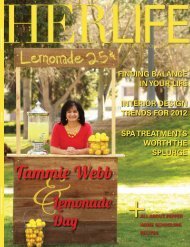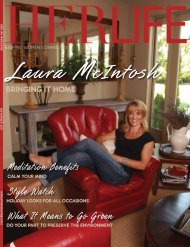GABRIELLA BIEDINGER - HER LIFE Magazine
GABRIELLA BIEDINGER - HER LIFE Magazine
GABRIELLA BIEDINGER - HER LIFE Magazine
Create successful ePaper yourself
Turn your PDF publications into a flip-book with our unique Google optimized e-Paper software.
herlife | culinaryMAKING A SPLENDID“SPOT” OF TEAby sherry l. granaderIf you ever have the opportunity to visit England or entertainsomeone from the UK, you will soon realize that, for the English,tea is both a beverage and a meal. I was raised in the U.S. byparents from England and Scotland, and afternoon tea was adaily ritual in our home. It was always an opportunity for my parentsto sit down and enjoy a delicious, hot cup of tea with cookies ortea sandwiches while catching up over the events of the day. Teatimeis one of life’s simple pleasures that help us retreat from the pressuresof the outside world and simply to enjoy each other.In the 19th century, Anna, the seventh Duchess of Bedford, createdthe ‘first tea’ because dinner was typically served fashionablylate. The British were known for eating a hearty breakfast followedby a light lunch, and did not return to the dinner table for the rest ofthe day. The duchess would ask for a small meal to be served in herprivate quarters in the late afternoon, eventually inviting friends overto join her.The ritual, ceremony and tradition of this specialized meal are apleasant solution to an increasingly frantic pace of today’s way of life.Afternoon tea is a mini-meal consisting of sweets, breads and smallsandwiches, plus a perfectly made hot pot of tea. High tea occurredat the end of a workday with a hearty spread of roasted meats,savory pies, pudding or custard and cakes. Although a traditional teausually consists of crustless sandwiches, finger foods and petit fourson a tiered stand of fine china, it’s a wonderful opportunity to blendfamiliar, well-loved tea dishes with the best of contemporary cuisine.There is nothing more delightful than grazing on small bites of delicious,yummy foods that incorporate non-traditional ingredientspresented in unexpected ways with a great cup of tea.In some of the most lavish, innovative restaurants in this country,restaurants and hotels are offering afternoon tea featuring the freshestingredients from local growers and suppliers. Sandwiches andtarts are garnished with fresh-picked produce such as raspberries,strawberries, enoki mushrooms, kiwi and daikon sprouts. Chefs areserving grilled shrimp or fish sprinkled with colorful edible flowers.Menu offerings for afternoon tea include an international mix thatreflects an increased interest in regional and ethnic foods.“Teatime” in the afternoon can be as simple as a great cup oftea, or a multicourse meal from casual to formal, for 2 persons to acrowd of 200. It can include elaborate dishes or just a cup of tea withsome sweets, informal sandwiches, scones and muffins. A teatimemeal can be flexible and reflect your personal style. Start with afreshly brewed, perfect pot of tea. It doesn’t matter if you pour it froma gold service set or a simple pottery teapot, the result is the same:mind, body and spirit are renewed and refreshed.Preparing a perfect pot of tea requires brewing the tea for justthe right amount of time, usually three to five minutes, so that tanninsare not released which can make the tea taste bitter. The English havealways enjoyed tea with fresh, cold milk, usually added to the cupfirst before adding the hot tea. Lemon, sugar or honey is optional.Use afternoon tea to mark a celebration, note the change in seasonsor simply to spend time with friends or family. Expand or varythe menu depending on the type of tea or time of day. Bring the traditionof afternoon tea to your home for family and friends to enjoy. ■Source: Teatime Celebrations by Patricia Gentry30 <strong>HER</strong><strong>LIFE</strong>MAGAZINE.COM
















